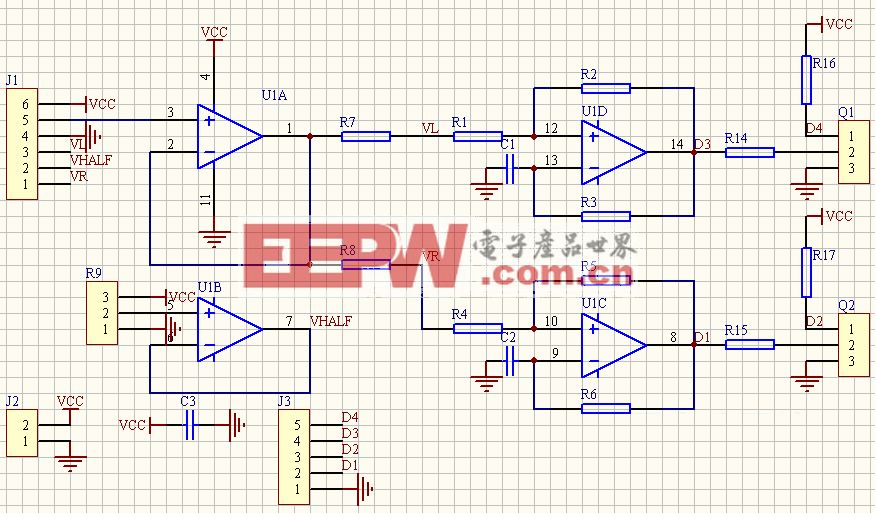隔離式電源電信應(yīng)用-Isolated Power Suppl
Multiple outputs (main plus auxiliary voltages) can be protected by devices such as the MAX869L and the MAX890L. In addition to current-measurement circuitry, these ICs include a power MOSFET in series with the measured load current, which can disconnect the load in response to overcurrent conditions. All these current measurements are performed on the positive rail, i.e., on the output. The alternative (measuring on the negative rail, or the common of the power supply) includes all current returned by the system. For a three-output system, for example, this means that every output must be designed to withstand all the current. Such negative-path loops in a complex system can actually produce wrong current measurements.
Because any failure within the converter can cause an out-of-spec output voltage with a catastrophic effect on the load, most systems include a simple circuit that monitors the output voltage continuously and stops the converter in case of an over- or undervoltage condition. Maxim offers a wide choice of such voltage monitors, such as the MAX6806. When the monitor reports a voltage failure via a protection loop, it must first stop the primary IC controller. If the failure persists, it must also (through a driver circuit) turn on an SCR connected in parallel with the converter's output. Once the SCR turns on, it can exit from the ON latching condition only when its current flow falls to zero.
Not all load circuits like to endure the dv/dt of a converter output as it rises from zero to nominal during turn-on. Most prefer to remain in a reset condition until the output voltage stabilizes. Maxim is the worldwide leader in generating such resets during startup. Simple ICs like the MAX809 or the MAX6351, for example, available in SOT23 packages and able to monitor 1 or more voltages, provide a "Power OK" signal with delay (typically 140mS). They also advise the system, with considerable precision, to save all necessary data before a declining supply voltage disappears completely.
Operating Temperature, Flammability, and Thermal Protection
UL 94VO, V1 or V2, defines limits for the maximum temperature inside an electrical system. Tests performed by qualified personnel in a certified laboratory must verify compliance before a UL stamp on the system can be approved. Thus, the thermal-management aspect of power-supply design should ensure, for the sake of system reliability, that the temperature of any hot spot caused by worst-case conditions remain within specified limits.The more critical components in a power converter are generally the primary power switches, the secondary rectifier diodes, and the isolating transformer. Good thermal coupling between the active components and a heatsink is desirable, unless the increased parasitic capacitance between the switch element and the heatsink exacerbates EMI.
High-temperature wire and insulating material per UL specifications ensures a high operating temperature for the isolation transformer. All materials must have a self-extinguish rating per UL94V0, 94V1; the use of such materials simplifies final UL recognition for the system. Even if the thermal operating temperature of a telecom system is defined by specification, an over- or undertemperature condition during normal operation (mainly over-) can have a catastrophic effect on the power supply. Barring immediate failure, the temperature fault can reduce equipment life by lowering the MTBF of components stressed by the hot temperature.
To avoid irreversible damage, thermal protection should include a double threshold: a logic alarm to advise that temperature is going out of specification and a second alarm (with a higher threshold) that shuts down the converter. Thermal protection must be placed close to the most critical component; that component is identified easily in a thermal map produced with an infrared camera.
Maxim's MAX6501/6502 thermal sensors monitor the ambient temperature with high accuracy and provide a logic signal when the threshold is reached. When compared with the traditional thermal switch, their high precision, semiconductor reliability, small mechanical dimensions (SOT23 packages), and low prices make them very attractive. MAX6503/6504 sensors for negative temperatures can advise when the temperature is lower than a specified minimum value; this is a condition that can affect the converter's ability to start up. An undertemperature logic signal can turn on a heat generator.
Feedback
The regulated output of a telecom power supply is generally tight (±5%), but in some cases greater accuracy is required. Influences that must be opposed in maintaining tight output accuracy include the effects of load variation (load regulation), line-voltage variation (line regulation), and temperature. Thus, the controller on the primary side must receive feedback from the regulated output voltage on the secondary side. To maintain the inherent isolation between primary and secondary windings, this feedback signal should be isolated as well. Three circuits are useful for this function:- Feedback via auxiliary transformer windings
- Feedback via optocouplers
- Feedback via extra magnetic parts, which allow communication between the primary and the secondary circuits
To obtain optocoupler feedback, an op amp on the secondary side (such as the MAX4122) continuously compares the output voltage with that generated by a voltage reference (such as the MAX6002). The op-amp output then drives the optocoupler diode, producing a feedback signal from the optocoupler proportional to the error difference between output and reference voltages. That is, a current transfer between the diode and the transistor (isolated from each other) produces a current output on the primary side. Flowing through a resistor, this current produces the signal voltage read by the primary-side controller (Figure 3).
By offering a wide choice of optocouplers already approved for this function by the safety agency, today's market aids safety qualification of the power supply. To further simplify procurement, all components in this circuit are standard parts.
For feedback using extra magnetic parts (which allow communication between the primary and the secondary circuits), the principle is the same as for an optocoupler. The secondary circuit is somewhat complex in this case, because the magnetic parts must be driven by a signal of a certain frequency rather than a DC current. The resulting extra expense of the feedback element (magnetic part) makes this solution less interesting, except for particular applications such as space equipment, in which the higher reliability of a magnetic part is appreciated.
Closing a feedback loop means designing a high-gain wide-bandwidth circuit that allows a fast response to line and load variations. Limits imposed by stability considerations, however, usually compel a compromise on the response time. Two parameters must be defined: crossover frequency (fC) and phase margin.
Overall gain in the feedback path (op amp, optocoupler, and primary controller) has a certain bandwidth, and the corner is that frequency at which the gain equals 1 (0dB). The op amp's inverting configuration introduces a 180° phase shift in the signal (negative feedback), and additional phase lag is introduced by the compensation network. Thus, the signal can exhibit a phase shift of 180° plus 180° or more, producing positive feedback that results in oscillation of the output voltage.
According to Nyquist, a system is stable if the added phase shift at fC is less than 180°. Therefore, a key parameter in power-supply design is phase margin at fC, defined as follows: How many degrees must be added to the feedback phase shift to obtain 180°?
Practical experience with various topologies has shown that a phase margin of 45° allows good load regulation with acceptable overshoot and undershoot, without permitting fast transients to trigger oscillation. Another good compromise is to limit the corner frequency: fC fSWITCHING/(2x3.14xD), where D is the maximum duty cycle.
Every power-supply feedback loop must be designed. Bode plots, offering a simple picture of gain and phase for the different elements, give an overall result when you add the pictures together (Figure 11). Bode says the gain slope for a single pole above its corner frequency is -20dB/decade and its phase shift is 90°. Thus, a double-pole LC network has a gain slope of -40dB/ decade a








評論